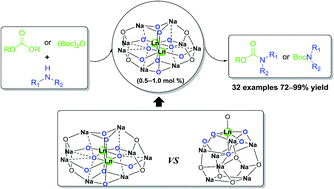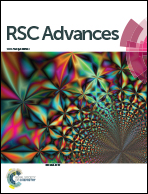Heterobimetallic dinuclear lanthanide alkoxide complexes as acid–base bifunctional catalysts for synthesis of carbamates under solvent-free conditions†
Abstract
Heterobimetallic dinuclear lanthanide alkoxide complexes Ln2Na8(OCH2CH2NMe2)12(OH)2 [Ln: I (Nd), II (Sm), III (Yb) and IV (Y)] were used as efficient acid–base bifunctional catalysts for the synthesis of carbamates from dialkyl carbonates and amines as well as the N-Boc protection of amines. The cooperative catalysts showed high catalytic activity and a wide scope of substrates with good to excellent yields under solvent-free conditions. The systems have shown higher catalytic activities due to the noteworthy synergistic interactions of Lewis acid center–Brønsted basic center. The comparison of catalytic efficiency between mono- and dinuclear heterobimetallic lanthanide alkoxide analogues was also investigated.


 Please wait while we load your content...
Please wait while we load your content...